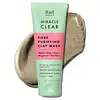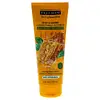What's inside
What's inside
 Key Ingredients
Key Ingredients

 Benefits
Benefits

 Concerns
Concerns

No concerns
 Ingredients Side-by-side
Ingredients Side-by-side

Water
Skin ConditioningKaolin
AbrasiveIllite
AbrasiveDipropylene Glycol
HumectantMagnesium Aluminum Silicate
AbsorbentHectorite
AbsorbentGlycerin
Humectant1,2-Hexanediol
Skin ConditioningMontmorillonite
AbsorbentArtemisia Scoparia Extract
Skin ConditioningHydroxyacetophenone
AntioxidantButylene Glycol
HumectantPolyglyceryl-10 Laurate
Skin ConditioningPolyglyceryl-10 Myristate
Skin ConditioningCentella Asiatica Leaf/Stem Powder
Melaleuca Alternifolia Leaf Powder
AbrasiveXanthan Gum
EmulsifyingDipotassium Glycyrrhizate
HumectantCarica Papaya Fruit Extract
Skin ConditioningCentella Asiatica Extract
CleansingSodium Phytate
Panthenol
Skin ConditioningSuccinic Acid
BufferingWater, Kaolin, Illite, Dipropylene Glycol, Magnesium Aluminum Silicate, Hectorite, Glycerin, 1,2-Hexanediol, Montmorillonite, Artemisia Scoparia Extract, Hydroxyacetophenone, Butylene Glycol, Polyglyceryl-10 Laurate, Polyglyceryl-10 Myristate, Centella Asiatica Leaf/Stem Powder, Melaleuca Alternifolia Leaf Powder, Xanthan Gum, Dipotassium Glycyrrhizate, Carica Papaya Fruit Extract, Centella Asiatica Extract, Sodium Phytate, Panthenol, Succinic Acid
Water
Skin ConditioningBentonite
AbsorbentSodium C14-16 Olefin Sulfonate
CleansingTitanium Dioxide
Cosmetic ColorantPumice
AbrasivePropylene Glycol
HumectantVinegar
Kaolin
AbrasiveXanthan Gum
EmulsifyingMagnesium Aluminum Silicate
AbsorbentCocamidopropyl Betaine
CleansingDisodium EDTA
Citric Acid
BufferingDiazolidinyl Urea
PreservativeMethylchloroisothiazolinone
PreservativeMethylisothiazolinone
PreservativeParfum
MaskingHexyl Cinnamal
PerfumingCI 15985
Cosmetic ColorantCI 16035
Cosmetic ColorantWater, Bentonite, Sodium C14-16 Olefin Sulfonate, Titanium Dioxide, Pumice, Propylene Glycol, Vinegar, Kaolin, Xanthan Gum, Magnesium Aluminum Silicate, Cocamidopropyl Betaine, Disodium EDTA, Citric Acid, Diazolidinyl Urea, Methylchloroisothiazolinone, Methylisothiazolinone, Parfum, Hexyl Cinnamal, CI 15985, CI 16035
Ingredients Explained
These ingredients are found in both products.
Ingredients higher up in an ingredient list are typically present in a larger amount.
Kaolin is a clay. It is used for oil control and to help minimize pores. Like other clays, kaolin has the ability to absorb excess sebum or oil. This can help clean out pores and mattify the skin.
Some types of kaolin may have exfoliating properties. When water is added to kaolin, it becomes a paste with small abrasive particles.
Most kaolin is a white color, but may be pink/orange/red depending on where it comes from.
The name 'kaolin' comes from a Chinese village named 'Gaoling'. Kaolin clay comes from rocks rich in kaolinite. Kaolinite, the mineral, has a silicate layered structure. Kaolinite is formed from chemical weathering of aluminum siilicate minerals.
Besides skincare, kaolin is commonly used to make glossy paper, in ceramics, toothpaste, and as medicine to soothe stomach issues.
Learn more about KaolinMagnesium Aluminum Silicate is a type of silica. It comes from naturally occuring minerals such as silicate ores and clay.
Magnesium aluminum silicate is used for enhancing texture and as an absorbent. Due to its large molecular size, it is unable to be absorbed into the skin.
Like other types of silica, this ingredient can be used to thicken a product. As an absorbent, it may be used to absorb extra water or help prevent clumping.
Although “aluminum” in an ingredient name can raise red flags for some consumers, the form and usage context matter significantly. For typical topical applications, there is no substantial evidence of health risks - such as cancer, neurotoxicity, or systemic “aluminum overload.”
Learn more about Magnesium Aluminum SilicateWater. It's the most common cosmetic ingredient of all. You'll usually see it at the top of ingredient lists, meaning that it makes up the largest part of the product.
So why is it so popular? Water most often acts as a solvent - this means that it helps dissolve other ingredients into the formulation.
You'll also recognize water as that liquid we all need to stay alive. If you see this, drink a glass of water. Stay hydrated!
Learn more about WaterXanthan gum is used as a stabilizer and thickener within cosmetic products. It helps give products a sticky, thick feeling - preventing them from being too runny.
On the technical side of things, xanthan gum is a polysaccharide - a combination consisting of multiple sugar molecules bonded together.
Xanthan gum is a pretty common and great ingredient. It is a natural, non-toxic, non-irritating ingredient that is also commonly used in food products.
Learn more about Xanthan Gum